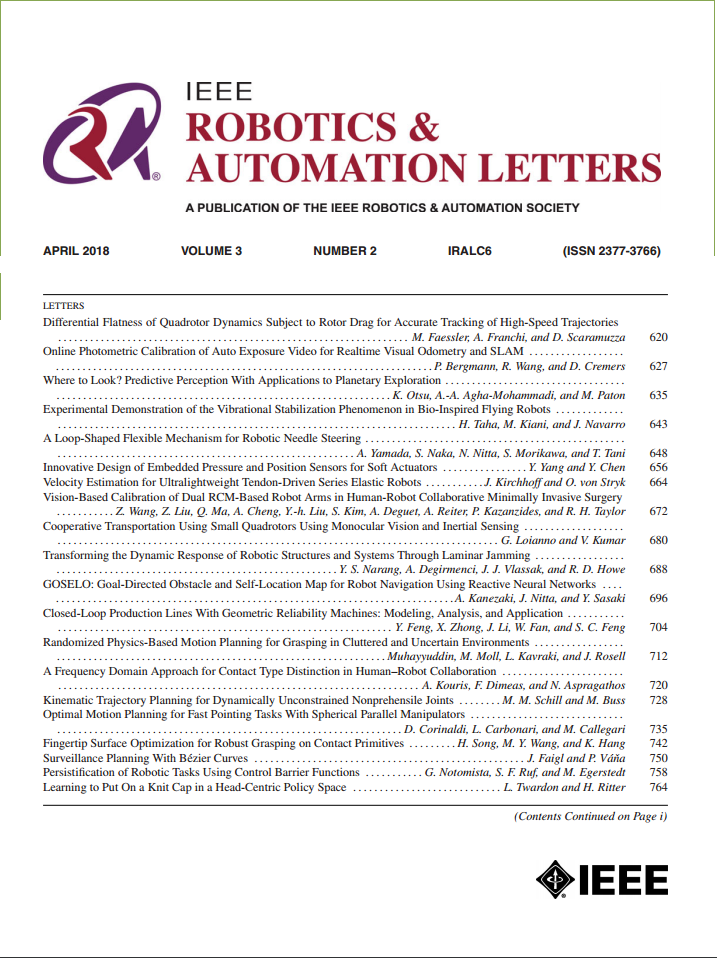A Proximity-Based Framework for Human-Robot Seamless Close Interactions
IF 5.3
2区 计算机科学
Q2 ROBOTICS
引用次数: 0
Abstract
The administration and monitoring of shared workspaces are crucial for seamlessly integrating robots to operate in close interactions with humans. Adaptive, versatile, and reliable robot movements are key to achieving effective and successful human-robot synergy. In situations involving unexpected or unintended collisions, robots must react appropriately to minimize risks to humans while still staying focused on their primary tasks or safely resuming them. Although collision detection and identification algorithms are well-established, more advanced robot reactions beyond basic stop-and-wait reactions have not yet been widely adopted and understood. This limitation highlights the need for more sophisticated robot responses to better handle complex collision scenarios, ensuring both safety and task continuity. This letter introduces a novel complete robotic system that leverages the potential of on-board proximity sensor equipment to seamlessly furnish compatible robot reactions while operating in close interactions. With on-board distributed proximity sensors, the robot gains a continuous close workspace awareness, facilitating a transparent negotiation of potential collisions while executing tasks. The proposed system and framework are validated in a collaborative industrial task scenario composed of sub-tasks allocated to the human and the robot and performed within shared regions of the workspace, demonstrating the efficacy of the approach.基于接近度的人机无缝密切交互框架
共享工作空间的管理和监控对于无缝集成机器人以与人类密切互动至关重要。自适应、通用和可靠的机器人运动是实现有效和成功的人机协同的关键。在涉及意外或意外碰撞的情况下,机器人必须做出适当的反应,以尽量减少对人类的风险,同时仍然专注于其主要任务或安全地恢复任务。尽管碰撞检测和识别算法已经很完善,但除了基本的停止-等待反应之外,更先进的机器人反应尚未被广泛采用和理解。这一限制突出了需要更复杂的机器人响应,以更好地处理复杂的碰撞场景,确保安全和任务连续性。这封信介绍了一种新颖的完整机器人系统,该系统利用机载接近传感器设备的潜力,在密切交互操作时无缝地提供兼容的机器人反应。通过机载分布式接近传感器,机器人获得持续的近距离工作空间感知,在执行任务时促进对潜在碰撞的透明协商。提出的系统和框架在一个协作工业任务场景中得到验证,该场景由分配给人和机器人的子任务组成,并在工作空间的共享区域内执行,证明了该方法的有效性。
本文章由计算机程序翻译,如有差异,请以英文原文为准。
求助全文
约1分钟内获得全文
求助全文
来源期刊

IEEE Robotics and Automation Letters
Computer Science-Computer Science Applications
CiteScore
9.60
自引率
15.40%
发文量
1428
期刊介绍:
The scope of this journal is to publish peer-reviewed articles that provide a timely and concise account of innovative research ideas and application results, reporting significant theoretical findings and application case studies in areas of robotics and automation.
 求助内容:
求助内容: 应助结果提醒方式:
应助结果提醒方式:


